Old Wine in New Wineskins: Applying Computational Methods in New Testament Hermeneutics
Abstract
1. Introduction
1.1. Computational Hermeneutics Past and Present
1.2. Methods
1.2.1. General Methodological Steps in Computational Analysis
1.2.2. Word Embedding
1.2.3. Topic Modelling
2. Topical and Semantic Structures in New Testament Texts
2.1. Finding the Topical Structure of New Testament Texts
2.2. Conceptual Analysis with Word Embedding
3. Comparison and Discussion of Integration of Literary and Historical Context
4. Concluding Remarks
Author Contributions
Funding
Data Availability Statement
Conflicts of Interest
| 1 | On conceptual history cf. Section 1.2 and Section 1.2.1 “Concepts” are in this context understood as second-order terms based on the calculated results through the computational experiments/analyses. Individually, words and terms are not concepts, but when we (through a computational/algorithmic model) have calculated their importance, we can treat them as second-order concepts, i.e., words that are calculated, and through this calculation, are considered to be “conceptual” and, thus, more than only first-order occurrences of important words. Terms, such as ψυχὴ and θεὸς, will have different nuances in New Testament and LXX texts (as we will show through our experiments), and computational methods, like topic modelling and word embedding, can assist in uncovering and analysing such differences based on the co-occurrence, i.e., the contextual structure of terms cf. Section 1.2. However, we are aware that no words are concepts “in themselves” in continuation of Wittgenstein’s language philosophy and James Barr’s critique of biblical “concepts” in The Semantic of Biblical Language (1961) and Comparative Philology and the Text of the Old Testament (1968). |
| 2 | The choice of these text groups is discussed in Section 2.2. We are aware that there are no “historiographies” in the strict (Greek) sense in the LXX, but we have chosen to designate the “history-writing” parts of the LXX (despite the ideological–religious biases) as historiographies. For scholars comparing the NT narratives with (Greek) historiographies, cf. Becker (2017) and Becker (2006). |
| 3 | For a definition of “computational humanities” as opposed to “digital humanities”, see Johnson et al. (2024). |
| 4 | Proponents have been, e.g., (Moretti 2000b; Underwood 2019; Pannapacker 2012; Jockers 2013; Nielbo et al. 2017); examples of critical voices are (Brennan 2017; Conrad 2014) and Da (2019a, 2019b). Cf. also Vrangbæk and Nielbo (2021, p. 151). |
| 5 | Already Jockers has spoken of a “blended method”, Jockers (2013, p. 26); for integrative approaches see also (Hu et al. 2021; Manjavacas Arevalo and Fonteyn 2022; Nielbo et al. 2019a, 2019b; Nielbo et al. 2017; Baunvig 2019, 2022, 2023; Agersnap et al. 2020; Agersnap et al. 2022). |
| 6 | An approach which we find supported in, e.g., (Hu et al. 2021; Nielbo et al. 2019a; Alkan et al. 2023; Gao and Xu 2021). |
| 7 | The figure and a similar description also appears in Vrangbæk (2024) (unpublished Ph.D. dissertation). The figure is inspired by Nielbo et al. (2017, p. 97) and Fayyad et al. (1996, p. 41). |
| 8 | Concerning choosing the right kind of vectorization, (see Mikolov et al. 2013b; Sineglazov and Savenko 2023; Turian et al. 2010, pp. 384–94). |
| 9 | Baunvig and Nielbo (2022, p. 24) comment that, “As is well known, ‘the map is not the territory’, but (functional) maps do, nevertheless, retain certain relevant properties of the territory it seeks to represent.” (cf. also Goldberg 2017, pp. 90–92; Albrecht et al. 2021, pp. 270–71). The paragraph builds on passages from Vrangbæk and Nielbo (2023) and Vrangbæk (2024). |
| 10 | |
| 11 | As explored in Vrangbæk et al. (2024). |
| 12 | Concerning “term frequency-inverted document frequency” (e.g., Zhang et al. 2011; Albrecht et al. 2021, pp. 132–33). |
| 13 | In our case, the corpus consists of a conglomerate of the Perseus Corpus, First1KGreek, the Pseudepigrapha.org corpus, LXX, and NA28, in sum, 2153 documents. This database is hosted by associate professor Jacob P.B. Mortensen, Aarhus University, in the project “Computing Antiquity”. |
| 14 | In our case, we carried out textual preprocessing with the OdyCy-pipeline (Kostkan et al. (2023)). |
| 15 | This was also the procedure of topic modelling in Vrangbæk et al. (2024). |
| 16 | In this analysis, we treat each NT text as a one, finished text following the main text of NA28. The topics that are assigned to the texts are calculated results that allow us to treat the words of the topics as descriptive concepts. |
| 17 | Cf. our conceptual approach that first-order terms based on modelling become second-order concepts. |
| 18 | The setting of NT narratives as one lump has clear methodological consequences, and for a future analysis of the individual New Testament narratives, a segmentation of each text is necessary. However, in this article, the textual setup serves the purpose of demonstrating and showcasing our approach. |
| 19 | Query parameters need to be set, and, in this case, we ask for six first-level associations and four second-level associations. |
| 20 | See parameters in the code: https://github.com/centre-for-humanities-computing/computing-antiquity/blob/main/src/embeddings/train_glove.py (accessed on 1 October 2024). |
| 21 | LXX historiographies is a label we have assigned to a group of texts that have historiographic elements, although not all texts are historiography proper. The text group comprises Genesis–Deuteronomium, Chronicles, Kings, and Samuel, including “apocryphal” writings, except III Maccabees. |
| 22 | We tested the results of the relation between χάρις and θεὸς with a different digital tool that is more common among scholars, namely the Thesaurus Linguae Graece. We set up an N-gram search of all Septuagint texts of χάρις and θεὸς with a 10-word distance. In this case, there are 4 occurrences in the texts that we have categorised as LXX historiographies, whereas we find 16 occurrences in the other Septuagint texts, among which many occur in the apocryphal texts which lie historically closer to the New Testament: Gen. 6,2 Νωε δὲ εὗρεν χάριν ἐναντίον κυρίου τοῦ θεοῦ; 30;27 Εἰ εὗρον χάριν ἐναντίον σου, οἰωνισάμην ἄν· εὐλόγησεν γάρ με ὁ θεὸς τῇ σῇ εἰσόδῳ; Gen. 43,17 ὁ δὲ θεός μου δῴη ὑμῖν χάριν ἐναντίον τοῦ ἀνθρώπου, καὶ ἀποστείλαι τὸν ἀδελφὸν ὑμῶν τὸν ἕνα καὶ τὸν Βενιαμιν; Kings 15,25 καὶ εἶπεν ὁ βασιλεὺς τῷ Σαδωκ Ἀπόστρεψον τὴν κιβωτὸν τοῦ θεοῦ εἰς τὴν πόλιν· ἐὰν εὕρω χάριν ἐν ὀφθαλμοῖς κυρίου. Esdras I 8,4; Judith 8, 18; 8, 23; 10,8; Tobias 1,12; 12,17; 12,18; II Macc 7,32; III Macc. 1,9; 6,36; Psalm 44,3; 83, 12; Prov. 18,22; Sir. 45,1; Baruch 1,13). Searches are based on Thesaurus Linguae Graecae© Digital Library. Ed. Maria C. Pantelia. University of California, Irvine. http://stephanus.tlg.uci.edu.ez.statsbiblioteket.dk (accessed on 12 October 2024). |
| 23 | The scatterplot is a frozen image of a 3D visualization, which is represented in 2D here. |
References
- Agersnap, Anne, Kirstine Helboe Johansen, and Katrine Frøkjær Baunvig. 2022. The Legacy of the Danish “Church Fathers” NFS Grundtvig and SA Kierkegaard in 11,955 Contemporary Sermons. Paper presented at the 6th Digital Humanities in the Nordic and Baltic Countries Conference (DHNB 2022), Uppsala, Sweden, March 15–18; pp. 159–67. [Google Scholar]
- Agersnap, Anne, Ross Deans Kristensen-McLachlan, Kirstine Helboe Johansen, Uffe Schjødt, and Kristoffer Laigaard Nielbo. 2020. Sermons as Data: Introducing a Corpus of 11,955 Danish Sermons. Journal of Cultural Analytics 5: 1–27. [Google Scholar] [CrossRef]
- Albrecht, Jens, Sidharth Ramachandran, and Christian Winkler. 2021. Blueprints for Text Analytics Using Python: Machine Learning-Based Solutions for Common Real World (NLP) Applications, 1st ed. Sebastopol: O’Reilly Media. [Google Scholar]
- Alkan, Bilal Barış, Leyla Karakuş, and Bekir Direkci. 2023. Knowledge Discovery from the Texts of Nobel Prize Winners in Literature: Sentiment Analysis and Latent Dirichlet Allocation. Scientometrics 128: 5311–34. [Google Scholar] [CrossRef]
- Anderson, Paul N. 2016. The Johannine Logos-Hymn: A Cross-Cultural Celebration of God’s Creative-Redemptive Work. In Creation Stories in Dialogue: The Bible, Science, and Folk Traditions. Shinjuku: Brill, pp. 217–42. [Google Scholar] [CrossRef]
- Armand, Cécile, and Christian Henriot. 2023. Beyond Digital Humanities Thinking Computationally: A Position Paper. Available online: https://shs.hal.science/halshs-04194570 (accessed on 1 October 2024).
- Bauckham, Richard. 2024. The Waves, the Wind, and the Wilderness: Some High Christological Narratives in Mark and John. In Early High Christology: John Among the New Testament Writers. Edited by Christopher M. Blumhofer, Diane G. Chen and Joel B. Green. Augsburg: Fortress Publishers. [Google Scholar]
- Baunvig, Katrine Frøkjær. 2019. Mapping Worldviews. Word-Embedding ’Heaven’, ’Earth’ and ’Hell’ in the Writings of Danish Nation Builder and Church Father NFS Grundtvig (1783–1872). Paper presented at the EASR: Religion—Continuations and Disruptions, Tartu, Estonia, June 25–29. [Google Scholar]
- Baunvig, Katrine Frøkjær. 2022. Ånd hos Grundtvig: En digitalhumanistisk skitse af begrebsbrugen i Grundtvigs værker. In Åndsfrihed i det moderne samfund. Edited by Ove Korsgaard and Michael Agerbo Mørch. Århus: Aarhus Universitetsforlag, pp. 65–102. [Google Scholar]
- Baunvig, Katrine Frøkjær. 2023. A Computational Future? Distant Reading in the Historical Study of Religion. In Stepping Back and Looking Ahead: Twelve Years of Studying Religious Contact at the Käte Hamburger Kolleg Bochum. Edited by Maren Freudenberg, Frederik Elwert, Tim Karis, Martin Radermacher and Jens Schlamelcher. Leiden: Brill, pp. 325–52. [Google Scholar]
- Baunvig, Katrine Frøkjær, and Kristoffer L. Nielbo. 2022. Mermaids Are Birds Embedding NFS Grundtvig’s Bestiary. In The 6th Digital Humanities in the Nordic and Baltic Countries Conference 2022, Uppsala, Sweden, March 15–18. Edited by Karl Berglund, Matti La Mela and Inge Zwart. Ceur Workshop Proceedings. Uppsala: DHNB, pp. 23–32. [Google Scholar]
- Becker, Eve-Marie. 2006. Das Markus-Evangelium im Rahmen antiker Historiographie. Wissenschaftliche Untersuchungen zum Neuen Testament. Tübingen: Mohr Siebeck. [Google Scholar]
- Becker, Eve-Marie. 2017. The Birth of Christian History: Memory and Time from Mark to Luke-Acts, 1st ed. The Anchor Yale Bible Reference Library. New Haven: Yale University Press. [Google Scholar]
- Bizzoni, Yuri, and Shalom Lappin. 2018. Predicting Human Metaphor Paraphrase Judgments with Deep Neural Networks. In Proceedings of the Workshop on Figurative Language Processing. Edited by Beata Beigman Klebanov, Ekaterina Shutova, Patricia Lichtenstein, Smaranda Muresan and Chee Wee. New Orleans: Association for Computational Linguistics, pp. 45–55. [Google Scholar]
- Boleda, Gemma. 2020. Distributional Semantics and Linguistic Theory. Annual Review of Linguistics 6: 213–34. [Google Scholar] [CrossRef]
- Boleda, Gemma, and Katrin Erk. 2015. Distributional Semantic Features as Semantic Primitives—Or Not. Paper presented at the 2015 AAAI Spring Symposium, Palo Alto, CA, USA, March 23–25; pp. 1–4. [Google Scholar]
- Brennan, Timothy. 2017. The Digital-Humanities Bust: After a Decade of Investment and Hype, What Has the Field Accomplished? Not Much. The Chronicle of Higher Education, October 15. [Google Scholar]
- Bühner, Ruben A. 2021. Messianic High Christology: New Testament Variants of Second Temple Judaism. Waco: Baylor University Press. [Google Scholar]
- Conrad, Kathryn. 2014. What the Digital Humanities Can’t Do. The Chronicle of Higher Education, September 8. [Google Scholar]
- Culpepper, R. Alan. 2024. Davidic Messianism in Matthew and John. In Early High Christology: John Among the New Testament Writers. Edited by Christopher M. Blumhofer, Diane G. Chen and Joel B. Green. Augsburg: Fortress Publishers. [Google Scholar]
- Da, Nan Z. 2019a. The Computational Case against Computational Literary Studies. Critical Inquiry 45: 601–39. [Google Scholar] [CrossRef]
- Da, Nan Z. 2019b. The Digital Humanities Debacle. Computational Methods Repeatedly Come Up Short. Chronicle of Higher Education, March 27. [Google Scholar]
- Ethayarajh, Kawin, David Duvenaud, and Graeme Hirst. 2019. Understanding Undesirable Word Embedding Associations. arXiv arXiv:1908.06361. [Google Scholar] [CrossRef]
- Fayyad, Usama, Gregory Piatetsky-Shapiro, and Padhraic Smyth. 1996. From Data Mining to Knowledge Discovery in Databases. AI Magazine 17: 37. [Google Scholar]
- Firth, John Rupert. 1957. A synopsis of linguistic theory 1930–1955. Studies in Linguistic Analysis, 1–32. [Google Scholar]
- Forger, Deborah. 2020. Jesus as God’s Word(s): Aurality, Epistemology and Embodiment in the Gospel of John. Journal for the Study of the New Testament 42: 274–302. [Google Scholar] [CrossRef]
- Gao, Jianbo, and Bo Xu. 2021. Complex Systems, Emergence, and Multiscale Analysis: A Tutorial and Brief Survey. Applied Sciences 11: 5736. [Google Scholar] [CrossRef]
- Gillings, Mathew, and Andrew Hardie. 2023. The Interpretation of Topic Models for Scholarly Analysis: An Evaluation and Critique of Current Practice. Digital Scholarship in the Humanities 38: 530–43. [Google Scholar] [CrossRef]
- Goldberg, Yoav. 2017. Neural Network Methods in Natural Language Processing. Edited by Graeme Hirst. San Rafael: Morgan & Claypool Publishers. [Google Scholar]
- Harris, Zellig S. 1954. Distributional Structure. WORD 10: 146–62. [Google Scholar] [CrossRef]
- Hu, Qiyue, Bin Liu, Mads Rosendahl Thomsen, Jianbo Gao, and Kristoffer L Nielbo. 2021. Dynamic Evolution of Sentiments in Never Let Me Go: Insights from Multifractal Theory and Its Implications for Literary Analysis. Digital Scholarship in the Humanities 36: 322–32. [Google Scholar] [CrossRef]
- Ifversen, Jan. 2007. Begrebshistorien efter Reinhart Koselleck. Slagmark-Tidsskrift for Idéhistorie 48: 81–104. [Google Scholar]
- Jensen, Kim Ebensgaard. 2014. Linguistics in the Digital Humanities:(Computational) Corpus Linguistics. MedieKultur: Journal of Media and Communication Research 30: 20. [Google Scholar] [CrossRef]
- Jockers, Matthew. 2013. Macroanalysis: Digital Methods and Literary History. Philadelphia: University of Pennsylvania Press. [Google Scholar]
- Johnson, Jessica Marie, Mimno, David, and Lauren Tilton, eds. 2024. Debates in the Digital Humanities: Computational Humanities. Minneapolis: University of Minnesota Press. [Google Scholar]
- Jurafsky, Daniel, and James Martin. 2024. Speech and Language Processing: An Introduction to Natural Language Processing, Computational Linguistics, and Speech Recognition. Third Edition Draft. Available online: http://www.web.stanford.edu/~jurafsky/slp3/ed3book.pdf (accessed on 1 October 2024).
- Kherwa, Pooja, and Poonam Bansal. 2019. Topic Modeling: A Comprehensive Review. EAI Endorsed Transactions on Scalable Information Systems 20: e2. [Google Scholar] [CrossRef]
- Koselleck, Reinhart. 1972. Einleitung. In Geschichtliche Grundbegriffe: Historisches Lexikon zur politisch-sozialen Sprache in Deutschland. Edited by Otto Brunner, Werner Conze and Reinhart Koselleck. Band 1. Stuttgart: Ernst Klett Verlag, pp. XIII–XXVII. [Google Scholar]
- Kostkan, Jan, Márton Kardos, Jacob Palle Bliddal Mortensen, and Kristoffer Laigaard Nielbo. 2023. OdyCy – A General-Purpose NLP Pipeline for Ancient Greek. In Proceedings of the 7th Joint SIGHUM Workshop on Computational Linguistics for Cultural Heritage, Social Sciences, Humanities and Literature. Dubrovnik: Association for Computational Linguistics, pp. 128–34. Available online: https://aclanthology.org/2023.latechclfl-1.14 (accessed on 1 October 2024).
- Lee, Daniel D., and H. Sebastian Seung. 1999. Learning the Parts of Objects by Non-Negative Matrix Factorization. Nature 401: 788–91. [Google Scholar] [CrossRef]
- Li, Yang, and Tao Yang. 2018. Word Embedding for Understanding Natural Language: A Survey. In Guide to Big Data Applications. Edited by S. Srinivasan. Cham: Springer International Publishing, vol. 26, pp. 83–104. [Google Scholar]
- Liu, Alan. 2016. Is Digital Humanities a Field?—An Answer from the Point of View of Language. Journal of Siberian Federal University. Humanities & Social Sciences 7: 1546–52. [Google Scholar]
- Mandikal, Priyanka, and Raymond Mooney. 2024. Sparse Meets Dense: A Hybrid Approach to Enhance Scientific Document Retrieval. Paper presented at the 4th Workshop on Scientific Document Understanding, Vancouver, BC, Canada, February 26; pp. 1–8. [Google Scholar]
- Manjavacas Arevalo, Enrique, and Lauren Fonteyn. 2022. Non-Parametric Word Sense Disambiguation for Historical Languages. In Proceedings of the 2nd International Workshop on Natural Language Processing for Digital Humanities. Edited by Mika Hämäläinen, Khalid Alnajjar, Niko Partanen and Jack Rueter. Taipei: Association for Computational Linguistics, pp. 123–34. [Google Scholar]
- Mikolov, Tomas, Ilya Sutskever, Kai Chen, Greg Corrado, and Jeffrey Dean. 2013a. Distributed Representations of Words and Phrases and their Compositionality. arXiv arXiv:1310.4546. [Google Scholar]
- Mikolov, Tomas, Kai Chen, Greg Corrado, and Jeffrey Dean. 2013b. Efficient Estimation of Word Representations in Vector Space. arXiv arXiv:1301.3781. [Google Scholar]
- Moretti, Franco. 2000a. Conjectures on world literature. New Left Review, 54–68. [Google Scholar]
- Moretti, Franco. 2000b. The slaughterhouse of literature. MLQ: Modern Language Quarterly 61: 207–27. [Google Scholar] [CrossRef]
- Nielbo, Kristoffer L., Katrine F. Baunvig, Bin Liu, and Jianbo Gao. 2019a. A Curious Case of Entropic Decay: Persistent Complexity in Textual Cultural Heritage. Digital Scholarship in the Humanities 34: 542–57. [Google Scholar] [CrossRef]
- Nielbo, Kristoffer L., Mads L. Perner, Christian Larsen, Jonas Nielsen, and Ditte Laursen. 2019b. Automated Compositional Change Detection in Saxo Grammaticus’ Gesta Danorum. Digital Humanities in the Nordic and Baltic Countries Publications 2: 321–32. [Google Scholar] [CrossRef]
- Nielbo, Kristoffer, Ryan Nichols, and Edward Slingerland. 2017. Mining the Past—Data-Intensive Knowledge Discovery in the Study of Historical Textual Traditions. Journal of Cognitive Historiography 3: 93–118. [Google Scholar] [CrossRef]
- Pannapacker, William A. 2012. Digital humanities triumphant? In Debates in the Digital Humanities. Edited by Matthew K. Gold. Minneapolis: University of Minnesota Press, pp. 233–34. [Google Scholar]
- Porsdam, Helle. 2013. Digital Humanities: On Finding the Proper Balance between Qualitative and Quantitative Ways of Doing Research in the Humanities. Digital Humanities Quarterly, 7. [Google Scholar]
- Porter, Stanley E. 2020. Johannine and Pauline Christology. In Johannine Christology. Leiden: Brill, pp. 11–30. [Google Scholar]
- Rhody, Lisa. 2012. Topic Modeling and Figurative Language. Publications and Research. January 1. Available online: https://academicworks.cuny.edu/gc_pubs/452 (accessed on 1 October 2024).
- Runesson, Anders. 2023. Judaism for Gentiles: Reading Paul beyond the Parting of the Ways Paradigm. Tübingen: Mohr Siebeck. [Google Scholar]
- Sherstinova, Tatiana, Olga Mitrofanova, Tatiana Skrebtsova, Ekaterina Zamiraylova, and Margarita Kirina. 2020. Topic Modelling with NMF vs. Expert Topic Annotation: The Case Study of Russian Fiction. In Advances in Computational Intelligence. Edited by L. Martínez-Villaseñor, O. Herrera-Alcántara, H. Ponce and F. A. Castro-Espinoza. Lecture Notes in Computer Science. Cham: Springer International Publishing, pp. 134–51. [Google Scholar] [CrossRef]
- Sineglazov, Victor M., and Illia M. Savenko. 2023. Comparative Analysis of Text Vectorization Methods. Electronics and Control Systems 2: 21–27. [Google Scholar] [CrossRef]
- Špiclová, Zdeňka, and Vojtěch Kaše. 2020. Distant Reading of the Gospel of Thomas and the Gospel of John: Reflection of Methodological Aspects of the Use of Digital Technologies in the Research of Biblical Texts. Open Theology 6: 423–39. [Google Scholar] [CrossRef]
- Turian, Joseph, Lev-Arie Ratinov, and Yoshua Bengio. 2010. Word Representations: A Simple and General Method for Semi-Supervised Learning. Paper presented at the 48th Annual Meeting of the Association for Computational Linguistics, Uppsala, Sweden, July 11–16; pp. 384–94. [Google Scholar]
- Uglanova, Inna, and Evelyn Gius. 2020. The Order of Things. A Study on Topic Modelling of Literary Texts.Paper presented at the Worshop on Computational Humanities Research (CHR 2020), Amsterdam, The Netherlands, November 18–20; pp. 57–76. [Google Scholar]
- Underwood, Ted. 2019. Dear Humanists: Fear Not the Digital Revolution: Advances in Computing Will Benefit Traditional Scholarship—Not Compete with It. The Chronicle of Higher Education, March 27. [Google Scholar]
- Vrangbæk, Christian Houth, Eva Elisabeth Houth Vrangbæk, Kristoffer Nielbo, Marton Kardos, and Jacob Mortensen. 2024. Non-Canonical Acts and their Topical Distribution. Paper presented at the First Semantic Digital Humanities Workshop at ESWC, Hernissos, Crece, May 27. [Google Scholar]
- Vrangbæk, Eva Elisabeth Houth. 2024. What is Love Other than Will. An Investigation of Augustine’s Concept of Love and Will Assisted by Computational Methods. Ph.D. dissertation, Aarhus University, Aarhus, Denmark. [Google Scholar]
- Vrangbæk, Eva Elisabeth Houth, and Kristoffer L. Nielbo. 2021. Composition and Change in De ciuitate Dei: A Case Study of Computationally Assisted Methods. In Paper presented at the Eighteenth International Conference on Patristic Studies Held in Oxford 2019. Volume 14, Augustine of Hippo’s De ciuitate Dei: Content, Transmission, and Interpretations. Edited by Markus Vinzent, Anthony Dupont and Gert Partoens. Leuven: Peeters. [Google Scholar]
- Vrangbæk, Eva Elisabeth Houth, and Kristoffer Nielbo. 2023. Love Between Desire and Will—An Investigation of Augustine’s Concept of Love Assisted by Computational Methods. In Augustine & Ethics, Augustine in Conversation. Lanham: Rowman & Littlefield. [Google Scholar]
- Wevers, Melvin, and Marijn Koolen. 2020. Digital Begriffsgeschichte: Tracing semantic change using word embeddings. Historical Methods: A Journal of Quantitative and Interdisciplinary History 53: 226–43. [Google Scholar] [CrossRef]
- Willkomm, Jens, Christoph Schmidt-Petri, Martin Schäler, Michael Schefczyk, and Klemens Böhm. 2018. A Query Algebra for Temporal Text Corpora. In Proceedings of the 18th ACM/IEEE on Joint Conference on Digital Libraries. Fort Worth: ACM, pp. 183–92. [Google Scholar]
- Zhang, Wen, Taketoshi Yoshida, and Xijin Tang. 2011. A Comparative Study of TF* IDF, LSI and Multi-Words for Text Clas sification. Expert Systems with Applications 38: 2758–65. [Google Scholar] [CrossRef]

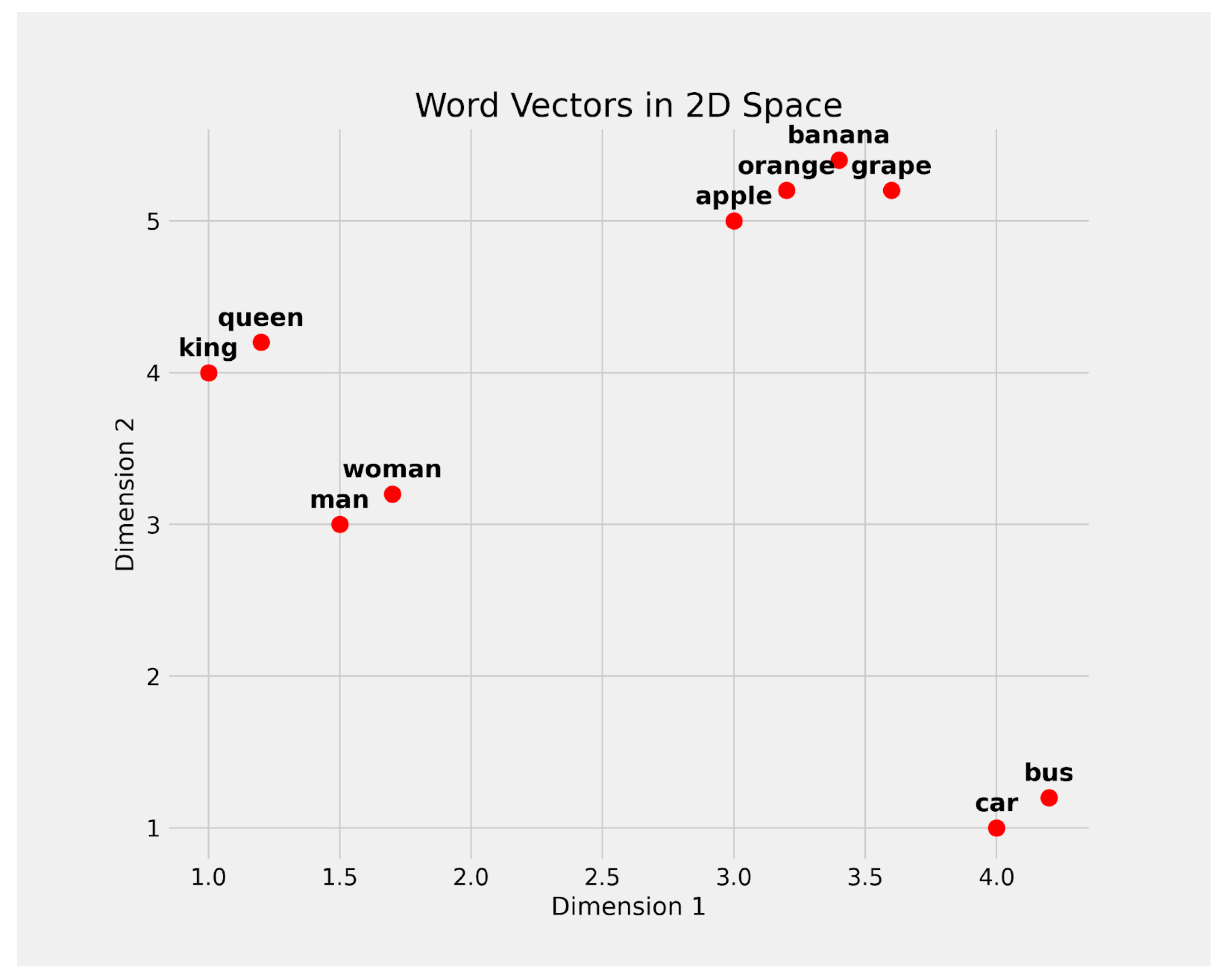
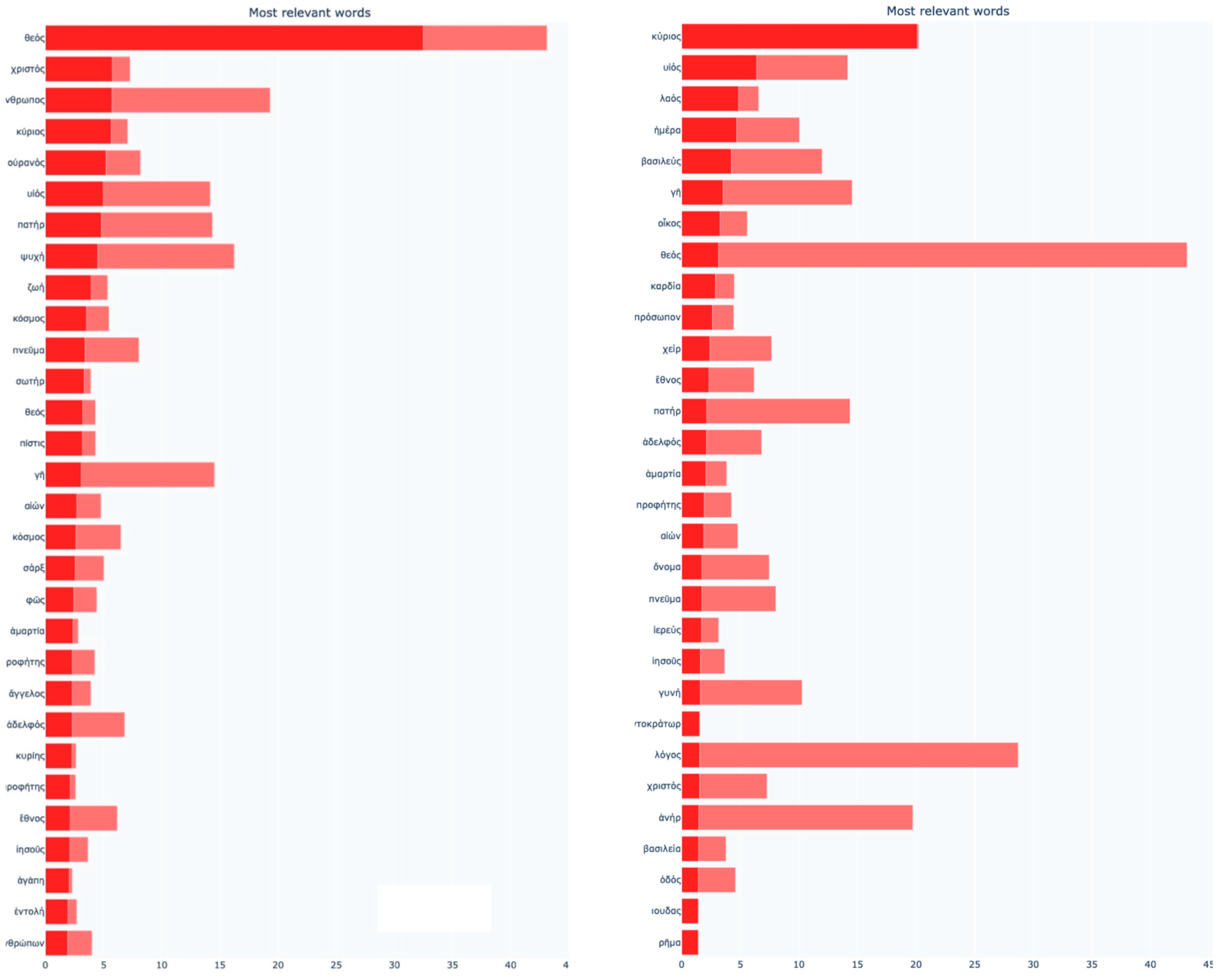
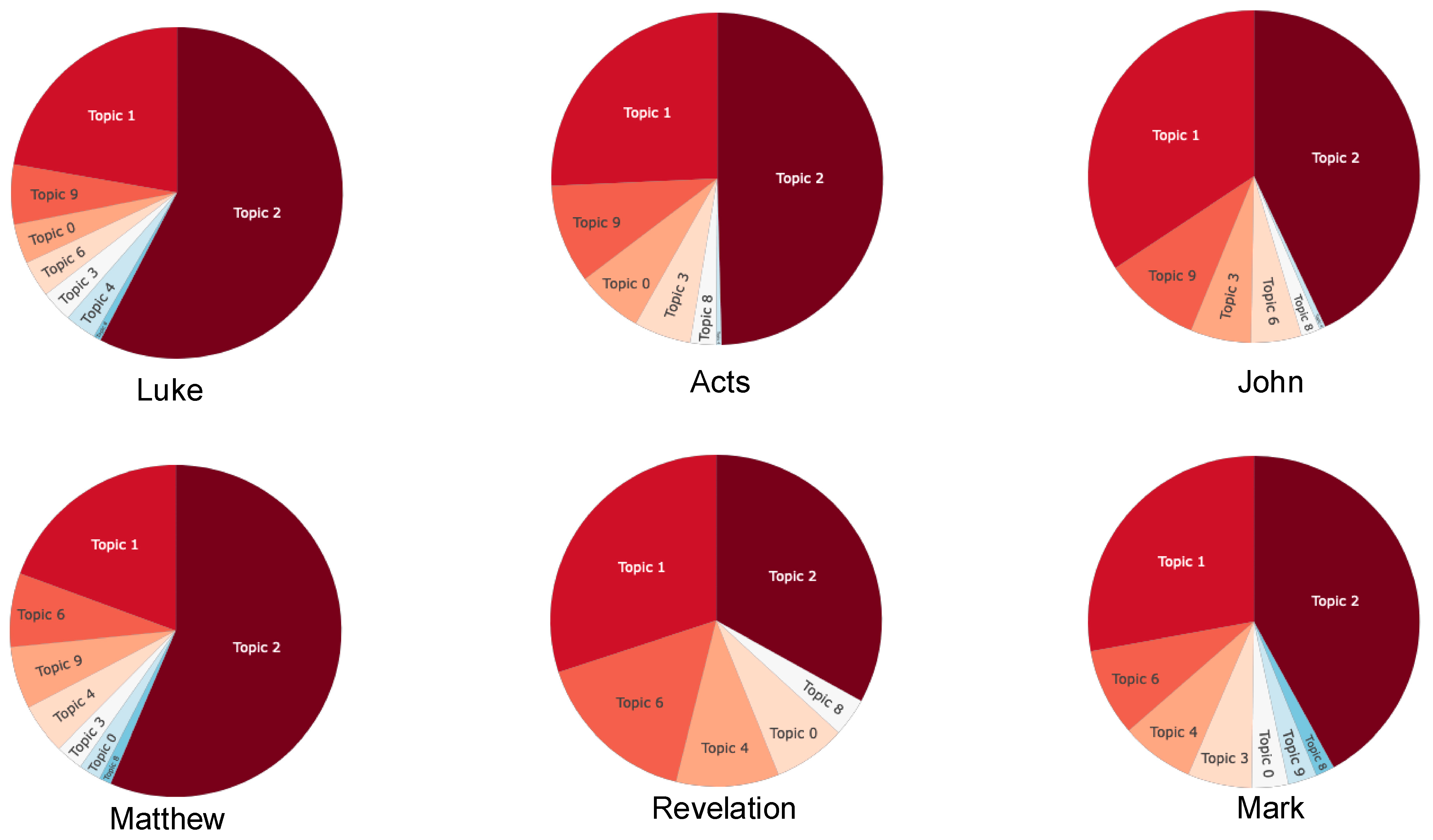

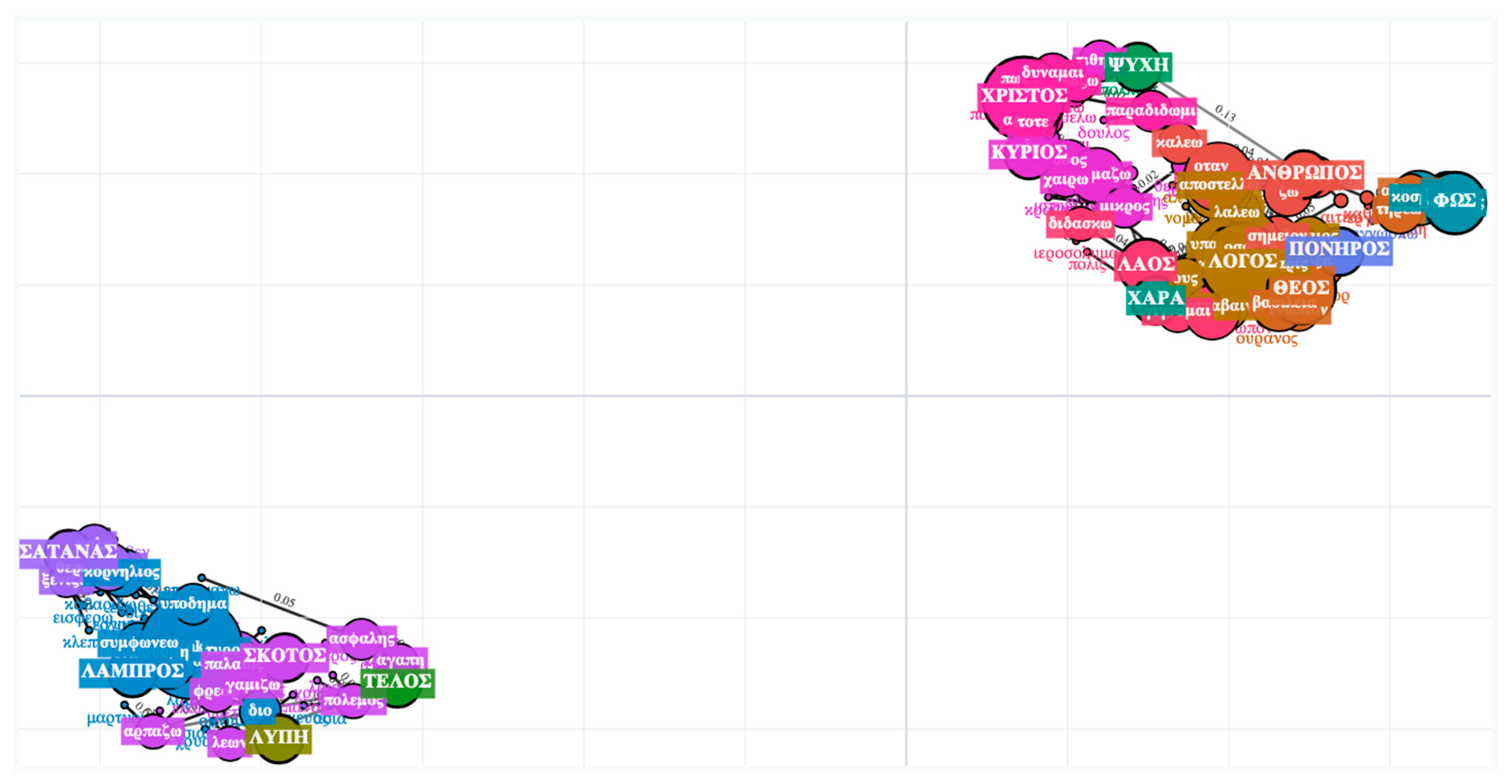

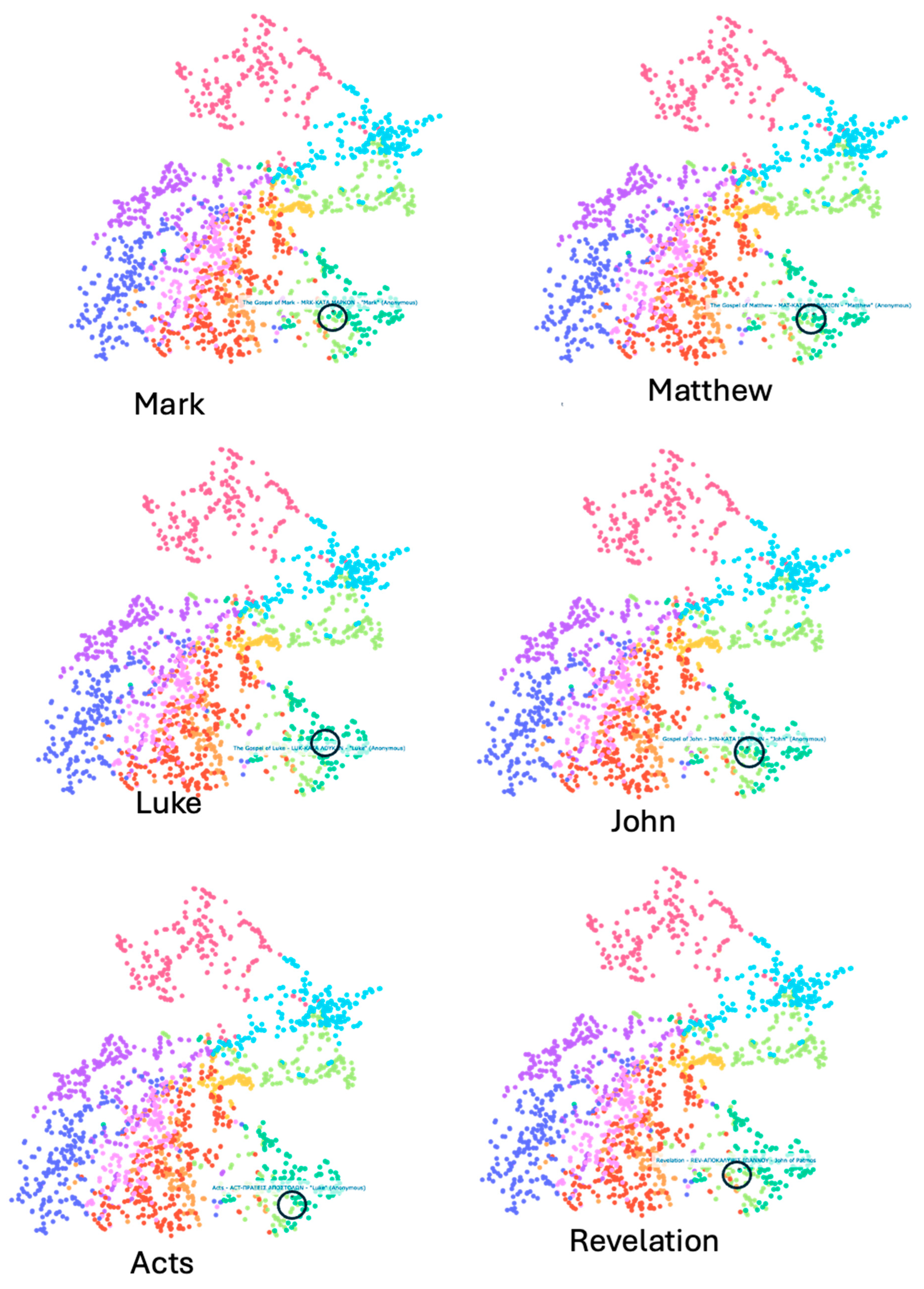
| No. | Top Topic Words (Calculated and Chosen) | Translated Words | Label (Interpreted) | Authors with High Distribution of Topic (Observed) |
|---|---|---|---|---|
| 0 | πόλις, πὸλεμος, βασιλεύς, ἕλλην, χώρα | city, war, ruler, Hellene, land | Greek History | Thucydides |
| 1 | θεός, ψυχή, οὐρανός, λόγος, χριστός | god, soul, heaven, word, Christ | Theology 1 | Galatians, Eusebius, Origen |
| 2 | θεός, κύριος, λαός, ἄνθρωπος | god, lord, people, human being | Theology 2 | Jeremiah, Judges, Chronicles |
| 3 | λόγος, φύσις, ἀρετή, ἄνθρωπος | reason, nature, virtue, human being | Greek Philosophy | Plato’s Phaedrus and Politeia |
| 4 | ζεύς, παῖς, ἔρως, κύπρις, ἀπόλλων | Zeus, child, love/Eros, Cypris, Apollo | Greek culture and religion | Homer, Hesiod |
| 5 | μόριον, τρόπος, οὐσία, άνάγκη, αίτία | part, character, being, necessity, cause | Medicine and ontology | Galen |
| 6 | σῶμα, ὕλη, ἀήρ, γή, ὕδωρ, πῦρ. | body, matter, air, earth, water, fire | Element Philosophy | Aristotle’s Problemata, Plato’s Timaeus |
| 7 | λόγος, πόλις, νόμος, τύχη, χάρις | reason, city, law, fortune, favor | Rhetoric and Philosophy | Libanius, Philo, Josephus |
| 8 | κύκλος, γωνία, κέντρον, σημεῖον, ἐπιφάνεια | circle, angle, center, sign, appearance | Geometry | Scholia in Euclidem |
Disclaimer/Publisher’s Note: The statements, opinions and data contained in all publications are solely those of the individual author(s) and contributor(s) and not of MDPI and/or the editor(s). MDPI and/or the editor(s) disclaim responsibility for any injury to people or property resulting from any ideas, methods, instructions or products referred to in the content. |
© 2024 by the authors. Licensee MDPI, Basel, Switzerland. This article is an open access article distributed under the terms and conditions of the Creative Commons Attribution (CC BY) license (https://creativecommons.org/licenses/by/4.0/).
Share and Cite
Vrangbæk, C.H.; Vrangbæk, E.E.H.; Mortensen, J. Old Wine in New Wineskins: Applying Computational Methods in New Testament Hermeneutics. Religions 2025, 16, 28. https://doi.org/10.3390/rel16010028
Vrangbæk CH, Vrangbæk EEH, Mortensen J. Old Wine in New Wineskins: Applying Computational Methods in New Testament Hermeneutics. Religions. 2025; 16(1):28. https://doi.org/10.3390/rel16010028
Chicago/Turabian StyleVrangbæk, Christian Houth, Eva Elisabeth Houth Vrangbæk, and Jacob Mortensen. 2025. "Old Wine in New Wineskins: Applying Computational Methods in New Testament Hermeneutics" Religions 16, no. 1: 28. https://doi.org/10.3390/rel16010028
APA StyleVrangbæk, C. H., Vrangbæk, E. E. H., & Mortensen, J. (2025). Old Wine in New Wineskins: Applying Computational Methods in New Testament Hermeneutics. Religions, 16(1), 28. https://doi.org/10.3390/rel16010028






